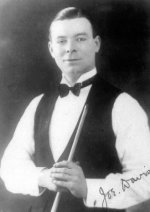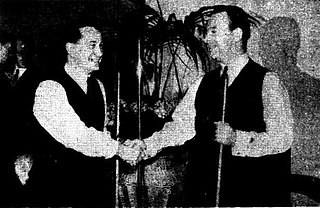Unofficial World Championship 1934
In June 1934, four-time World Billiards Championship winner Joe Davis traveled to Australia to play at the 1934 championship. [7] Davis played Walter Lindrum, the defending champion, in Melbourne, from 14 to 27 October. Walter Lindrum won a close match 23,553–22,678. [8] Davis was scheduled to depart Australia on 30 October but accepted an invitation to play against Horace Lindrum at snooker, delaying his departure until 7 November. [9] An 81-frame match was scheduled at the Tivoli Billiard Theatre, Bourke Street, in Melbourne from 29 October to 6 November with two sessions of five frames played each day. [10] [11] Davis insisted on using the same table from the World Billiards Championship final. [12] The match was described as the unofficial World Championship final. [13] [14]
Lindrum won the first two frames of the match, but Davis led 6–4 at the end of the first day. Davis made a break of 56 in the fifth frame. [13] Davis extended his lead to 12–8 on the second day [15] and then won eight frames on the third day to lead 20–10. Davis made breaks of 56 and 54 on the third day. [16] Davis extended his lead to 27–13 on the fourth day [17] but Lindrum won six frames on the fifth day to leave Davis 31–19 ahead. [18] On Saturday, the sixth day, Davis won 8 frames to lead 39–21, including a 50 break. [19] Davis won two frames on Monday afternoon to take a 1-2 lead. With the result decided, the match became more open, as Lindrum had breaks of 54 and 80, the highest of the match. [20] The final Tuesday afternoon session was abandoned, because it clashed with the Melbourne Cup. After a final evening session of five frames, Davis finished 46–29 ahead. [14] [21] Fred Lindrum criticised Davis for demanding a £100 side bet and for insisting on the use of the match table on which he had recently played. [22]
Trips to England 1935-1947
Lindrum arrived in England in October 1935 and stayed until his return to Australia at the end of March 1939, only returning to Australia for a brief period in the middle of 1937. [23] [24] After his arrival, Lindrum played a week-long billiards match against Tom Newman at Thurston's Hall. Given a handicap of 2,000, he won 8,348 to 7,883. [25] Lindrum then played Joe Davis in a billiards match, which had two frames of snooker played at the end of each session. Davis gave a 3,000 start but still won 10,348 to 9,847, although Lindrum won the snooker, 14–10. [26] In December, Lindrum played two snooker-only best-of-61 matches against Joe Davis over successive weeks at Thurston's Hall. Lindrum received a seven-point start in each frame. Lindrum won the first match, 31–30, while Davis won the second, 32–29. Davis won the side stakes for the overall aggregate score and for the highest break of 104, scored on the final evening, the only century break in the two matches. [27] [28]
The early part of 1936 was taken up with the 1935/1936 Daily Mail Gold Cup. This was a handicap billiards event, with Lindrum handicapped in the middle of the 7 competitors, receiving points from 3 and giving them to the other 3. Lindrum won three of his six matches. [29] The Gold Cup was immediately followed by the World Snooker Championship. Lindrum met Bert Terry in the first round, Clare O'Donnell in the quarter-final, and Stanley Newman in the semi-final, winning all his matches comfortably. In the final, Lindrum met defending champion Joe Davis. Lindrum led 6–4 and 11–9, [30] [31] before Davis won four out of the next five frames with top breaks of 75 and 78 to lead 13–12. However, Lindrum levelled the match at 15–15, [32] [33] before winning six out of ten frames to lead 21–19, [34] [35] and led at the conclusion of the penultimate day 26–24. He then won the first frame of the final day, to lead 27–24, [36] before Davis won the last ten frames in a row to win 34–27, having already won the match 31–27. [37]
The 1936 Daily Mail Gold Cup was played as a snooker competition, reflecting snooker's growing importance. It was a handicap event, with Joe Davis handicapped as the best player. Lindrum received a 7-point start in each frame from Davis but had to give starts ranging from 7 to 28 to the other four competitors. Lindrum was second in the event behind Davis, winning three of five matches. His defeats were by 35–36 to Sidney Smith, giving Smith a 7-point start, and by 30–41 in the final match of the tournament to Davis. [38] [39] The main part of the 1937 World Snooker Championship did not start until late February, and the early part of 1937 was mostly taken up with snooker exhibition matches between Lindrum and Davis, with Lindrum always receiving a 7-point start in each frame. There were four matches played over a total of 30 days, and, with 12 frames per frame being played, they played some 360 frames against each other in the period. Lindrum won the first match in Manchester, 39–36, a match that included a break of 141 by Lindrum. [40] The following week, in Coventry, Davis won 39–32. [41] Lindrum then won 74–69 in a two-week match at Thurston's Hall. [42]
Lindrum returned to London to compete in the 1937 World Snooker Championship. He won his quarterfinal against Sydney Lee and his semifinal against Willie Smith comfortably, and met Joe Davis again in the final. The first day was level at 5–5 [43] but Lindrum led 11–9 [44] and extended this to 17–13 at the half-way stage. [45] The fourth day started with a break of 103 by Davis in frame 31. Davis fouled on his first visit to the table, and, after a break of 29 by Lindrum, Davis cleared the table on his second visit. Davis reduced the deficit to 21–19 on the fourth day [46] and then won eight frames on the fifth day to lead 27–23. [47] After the final afternoon session, Davis still led 29–26, with Lindrum needing to win five of the six evening frames. Lindrum won the first two, but Davis won the next two to win the match 31–28. The last two frames were shared to give a final result of 32–29. [48] His match against Smith was spotlighted by the BBC in a 10-minute segment before they broadcast snooker. [49] [50]
Lindrum returned to Australia in the middle of 1937, playing a series of exhibition matches with Melbourne Inman. [51] He returned to England in time to play in the Daily Mail Gold Cup. He was again ranked as the second-best player, receiving 10 points per frame from Joe Davis and conceding points to the other competitors. [52] Lindrum lost his first two matches, won the next three, and lost to Davis 37–34 in the final match. He finished third in the final table. [53] Lindrum did not enter the 1938 World Snooker Championship because he objected to certain conditions, particularly the cloth used. [54] However, he played a two-week exhibition match against Davis, the new champion, at Thurston's Hall immediately after the championship. Lindrum received 10 points in each frame, but Davis won 71–62. [55] He ended the season by beating Fred Davis 39–34, despite conceding 14 points per frame. [56]
Lindrum started the 1938/39 season playing a couple of exhibition matches against Joe Davis, Davis conceding 10 points per frame. Davis won both matches, 39–32 in Edinburgh and 37–34 in Newcastle upon Tyne. [57] [58] In the Daily Mail Gold Cup, Lindrum was again handicapped as the second strongest player but now received 20 points per frame from Joe Davis. The tournament was a disappointment for Lindrum, who lost his first four matches before beating Davis 36–35 in the final match. [59] [60] Lindrum played in the 1939 World Snooker Championship, but he lost his first match 14–17 to Alec Brown. [61] Lindrum ended his disappointing season by playing Joe Davis in an exhibition match. Davis conceded 21 points per frame but still won 39–34. [62] Lindrum returned to Australia, arriving in late August. [63] During this time, Lindrum made an unofficial maximum break in New South Wales, the first to be made in competitive play. [64] Lindrum planned to return to England later in the year, but because of World War II he did not return until August 1945. [65] [66] At the 1946 World Snooker Championship Lindrum won his quarterfinal match against Herbert Holt and beat Fred Davis in the semi-final to meet Joe Davis in the final for the third time.
Lindrum played in the World Championship in 1947 and 1951 where he lost to Walter Donaldson in the semi-final on both occasions. [67] [68] [69] During a trip to India in 1952, Lindrum made the first century break in the country. [70]
Later years and death
By 1957, Lindrum retired from competitive play to become an exhibition player, touring Australia and South Africa and describing himself as the "undefeated world champion." [71] In 1963, the Australian Professional Billiards and Snooker Association asked him to return to competitive play to combat the flagging interest in the sport in Australia. The president of the Australian Association, Dennis Robinson, described Lindrum's return to competitive play as a 'magnanimous gesture', and the program published for the event contained 'a tribute to Lindrum'. That year, Lindrum won the Australian Open. [75] [73]
Lindrum died on 20 June 1974 at the Delmar Private Hospital, Dee Why, Sydney, of a bronchial carcinoma. Joy, his wife, and their two daughters survived him. [76]





